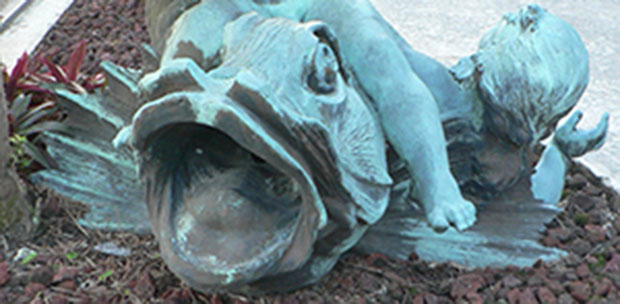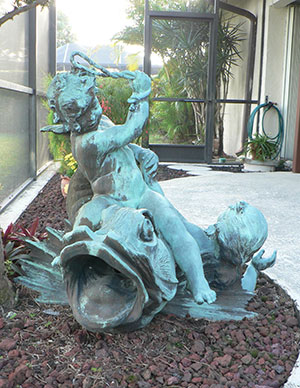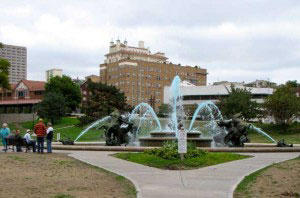
A piece missing from the sculpture for decades will be part of it when the fountain reopens. Courtesy Kansas City Parks and Recreation Department.
A major Country Club Plaza attraction for tourists and citizens is gone, but the dramatic fountain with a soap opera history will return in the spring, rejuvenated for decades to come.
Workers carefully hauled off the statuary Wednesday from the east entrance of the Plaza.
The J.C. Nichols Memorial Fountain statuary will be cleaned and waxed, its pumps and motors upgraded, its concrete bases fixed and more.
 A dolphin from the original sculpture in 1910 vanished over the years and was located in Florida. It will be restored to the statuary when the fountain reopens and a dolphin made to replace it will be displayed elsewhere in Mill Creek Park.
A dolphin from the original sculpture in 1910 vanished over the years and was located in Florida. It will be restored to the statuary when the fountain reopens and a dolphin made to replace it will be displayed elsewhere in Mill Creek Park.
The restoration work was made possible largely by a $200,000 contribution from the Miller Nichols Charitable Foundation.
In the 1950s, Miller Nichols brought the fountain and sculptures to the city as a memorial for his father, J.C. Nichols.
Jocelyn Ball-Edson, landscape architect for the Parks Department, explained the symbolic significance of the statuary as proposed by a curator of the Nelson Atkins museum:
The “four horse-and-rider figures represent 4 rivers of the world, probably the Volga (with the bear); the Mississippi (with the alligator); the Rhine (rider fighting a merman, while draped in a ram’s skin); and the Seine (also fighting a merman). It’s a theory, but a good one, and I guess I would say the fish (“dolphin”) sculptures with the putti (children / cherubs) are a fairly common motif in European art, and fit nicely with the theme of rivers.”
The statuary was created in Paris by French artist Henri Greber and the fountain originally was part of Harbor Hill, the Long Island mansion of industrialist Clarence H. Mackay, long one of the nation’s wealthiest men.
He was the son of John W. Mackay, a force in developing the richest silver miles in the Comstock Lode in Nevada in the 1860s and 70s, but Clarence was not like his father.
Clarence was respectable and restrained, a churchman, philanthropist, music lover, horseman, polo player, squash and tennis player, and bird hunter. His collection of medieval armor was so extensive he had a worker just to polish it.
But the great stock crash of 1929 hit him hard. In 1933, he was forced to sell some of his art and that armor is now in many museums. In 1933, he and his wife had to close Harbor Hill mansion. He died in 1938 with an estate valued at only 2 to 3 million dollars, up to 100 times less than it had once been worth.
The mansion and the fountain were vandalized, and the mansion demolished by dynamite in 1947.
The property went to a developer who built a series of homes on Harbor Hill in the late 1950s and early 1960s that is now known as Country Estates.
According to The City of Fountains book:
The Nichols family started toward purchase of the fountain in the early 1950s by raising private contributions. They raised more than $50,000, some of it donated by school children.
Artist Herman Fredrick Simon refurbished it in Kansas City and also created 14 missing pieces. It was dedicated here in 1960.
When it opens in the spring, it will be 105 years old and shining.




Trackbacks